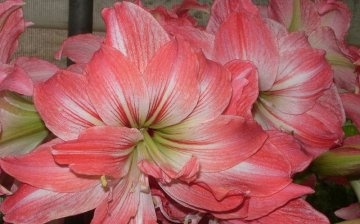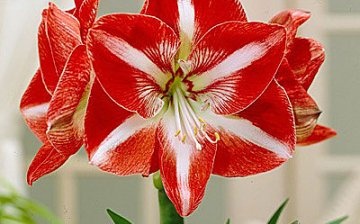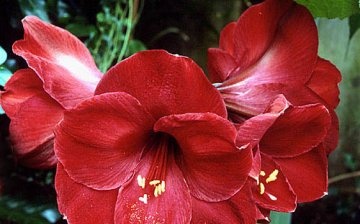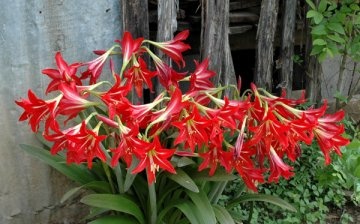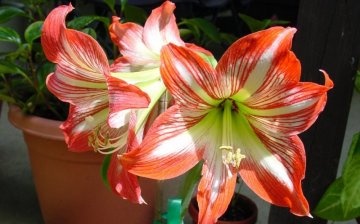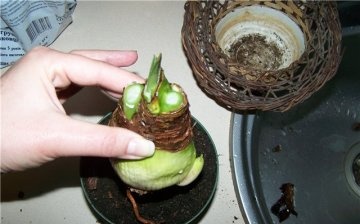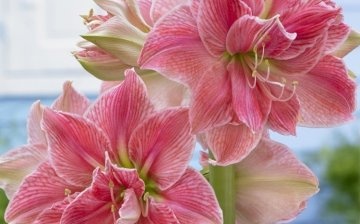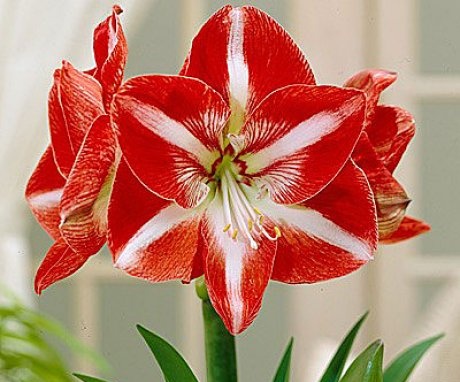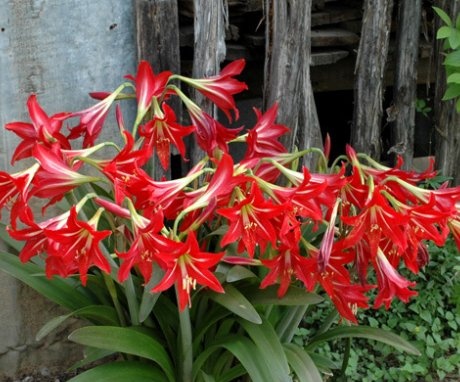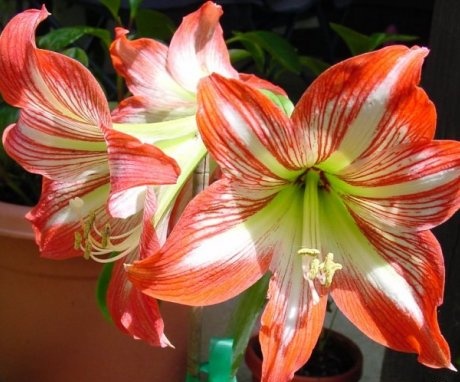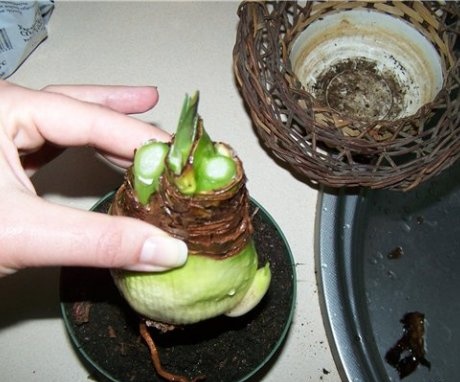Growing and caring for amaryllis flower, breeding methods, pest control
Amaryllis is a rare plant that requires special climatic conditions to grow. The rest of the care is pretty simple.
Content:
- Description of amaryllis flower
- The difference between amaryllis and hippeastrum
- Growing amaryllis outdoors
- Growing hybrid varieties of amaryllis as a houseplant
- Reproduction of amaryllis
- Possible growing problems
Description of amaryllis flower
Amaryllis is a perennial bulbous plant. It came to us from America, although it is found naturally in South Africa. The plant is prized for its bright, unusual flowers.
Amaryllis is a genus of plants that belongs to the Amaryllis family. There is only one type of plant in total, but gardeners have bred several different hybrid varieties. It is rarely possible to meet a real Amaryllis belladonna (beauty) at home.
All hybrid forms are called hippeastrum, they can be grown in culture.
Flower features:
- Amaryllis has long, linear-lingual leaves. Their length reaches 50 cm, and their width is 3 cm, the arrangement is parallel in two rows. They begin to appear with the onset of spring, and in their natural habitat in the fall.
- The flowers are planted on tall, resilient peduncles. Bell-shaped flowers, the palette of colors ranges from white to dark red, green petals may be found. The surface of the petals is terry.
- A feature of amaryllis is a pronounced sweet aroma. The flowers are not arranged separately, but are collected in large inflorescences, which are like a whole bouquet.
- Amaryllis is a thermophilic flower, this property was promoted by the place of origin. Flowers begin to appear in early autumn and fall off by the end of the season.
Amaryllis is grown either at home or in pots on the streets. When wintering in the open field, the plant will die. The plant is actively developing and does not require much attention to itself.
In addition to being a beautiful flower, amaryllis sap is deadly poisonous.
In ancient times, arrowheads were smeared with juice. But now "belladonna" is being treated for spasms and convulsions, but again it is important not to overdo it with quantity. Both the plant itself and the bulbs are dangerous.
The difference between amaryllis and hippeastrum
In the fall, amaryllis are sold in markets and gardening shops, but they often sell hippeastrum under their guise, which outwardly differ little, but are less valuable. In order not to be fooled, you need to remember a few rules on how to distinguish a real amaryllis from a hybrid variety.
Both plants have the following characteristics:
- Large bulbs
- Peduncles with umbrellas
- Funnel-shaped flowers
- The flowers in the inflorescence are like lily flowers
But there are differences that are difficult to detect with an unprepared naked eye:
- The flowers of hybrid varieties are larger, they reach 15 cm in diameter, while in amaryllis it is no more than 8 cm.The flowering of amaryllis occurs only after the leaves die off, but in the hippeastrum, both leaves and inflorescences can be on the plant at the same time.
- In amaryllis, the peduncle has a dense structure; it contains from 6 to 12 flowers. In hippeastrum, the peduncles are empty inside, the structure is fragile, the maximum number of buds is 6 pieces, only 2 can bloom.
- If the climate and environmental conditions permit, then real amaryllis can be grown outdoors in the open field. But hippeastrum is grown only at home in a pot.
Amaryllis belladona (beauty, beautiful) in translation means "beautiful lady", which fully corresponds to the appearance of the flower. The flowers can be white, pink or red, the umbrella is tubular, the height of the peduncle is 60 cm on average. The leaves are opposite, their shade is dark, 40 cm long, are absent during flowering, grow after the flowers die off. The bulb is pear-shaped, large, can have many babies.
The bulb of the hippeastrum does not form children.
Hippeastrum blooms in late winter and early spring, while amaryllis blooms only in autumn. The flowers of this kind have a pleasant aroma, but the hybrid varieties do not smell at all.
Growing amaryllis outdoors
Only amaryllis can be grown in the garden, by no means hippeastrum. You can plant a flower only in warm regions, where severe frosts do not come in winter, which are destructive for the plant.
A prerequisite for growing amaryllis is well-drained soil.
Without it, it makes no sense to comply with the remaining requirements. Above the main soil, there should be a sowing layer of 20 cm. The bulb can be planted after October, but before the onset of heat, that is, April. Before planting, a flower is prepared. It is placed in a vessel so that the water covers the roots and base. In this position, the plant is left for 3-4 hours.
If you have time, you can place the bulbs in a cool, dark room for a while. The ambient temperature should be 4-10 degrees Celsius. You can use a refrigerator or cellar for storage. Apples should not be stored nearby, this can lead to infertility. Before planting in open ground, the bulb is placed in a pre-prepared mixture - fertile compost. It is important not to damage the root system. To keep the bulb well, press it down with your hands.
When planting amaryllis:
- The bulb must be deepened by a third or half the height.
- A distance of about 30 cm should be maintained between the plants, as much as possible, but depending on the composition.
- After that, you can water the onion.
After 2-3 months, the plant will begin to bloom. If amaryllis was planted closer to winter, then this period of disclosure may be delayed. In the period from December to March, the flower begins a dormant period. For plants to bloom, replacing each other, they need to be planted after two weeks.
Amaryllis flower care is as follows:
- Regular watering
- Soil mulching
- Weed removal
- Fertilization
Amaryllis loves moisture, so that it stays longer, the soil needs to be mulched. Mulch will also protect the plant from weeds.
The bulb is placed in a vessel and left in the sun to set the stems. The optimum ambient temperature is 20 degrees. Until the stems appear, watering should be moderate, then increase it. As they bloom, wilted flowers are removed so that they do not spoil the appearance and do not interfere with seed development.
As a fertilizer, you can prepare a mixture of perlite and peat. Watering and fertilizing is carried out throughout the warm period. The leaves should receive maximum nutrients and moisture. When the flower withers, the bulbs will need to be removed for storage. The top of the plant is trimmed and the bulb is peeled.
Growing hybrid varieties of amaryllis as a houseplant
Hybrid varieties or hyperstrules are grown only at home. It is very important to choose a suitable place for the plant. This should be the brightly lit side of the room, but without direct sunlight directly on the flower. The flower also reacts painfully to drafts.
Amaryllis does not begin to bloom in the first year after planting, at least 3 years should pass. The plant is planted in a narrow pot, it should not be much wider than the bulb itself.
The bulb should be inspected for damage before planting. It should be clean, without cracks, dry, but not depleted, the root system should be fibrous, poorly expressed.
If the bulb is affected by rot, then it must be cleaned and disinfected. To eliminate the infection, the bulb is soaked for a couple of hours in a solution of potassium permanganate, then magnesium, lime or wood ash is used.
Several bulbs can be planted in one container at once. The only condition is that at least two centimeters should remain to the edge of the pot, and about 10 centimeters between the bulbs. If the task is to obtain a large number of tubers, then this is possible only to the detriment of flowering. A good drainage layer is laid at the bottom of the pot, the bulb is dug into the ground about two-thirds of the height or half.
The soil can be prepared independently, for this it is taken:
- 2 pieces of leafy land
- 2 parts of turf land
- 2 parts of humus earth
- 1 part sand
When the dormant period comes, the pot is placed in a dark, cool place, it is good if it is possible to provide a temperature of 10 degrees. After that, the pots are placed in a warm place and do not water until a flower arrow appears; during this period, the pot is covered with another vessel. When the sprout appears, you can allow diffused light.
Until the arrow has grown at least 7 centimeters, the soil is not watered abundantly, this can activate the growth of leaves, and not flowers.
Top dressing is applied in spring and summer. Mineral and organic fertilizers are used in turn, which are applied once every one or two weeks. Since the plant loves moisture, it will not refuse to spray from a spray bottle. But only during the rest period should the air be dry.
Reproduction of amaryllis
Reproduction of amaryllis is carried out in two ways:
- Using seeds
- Daughter bulbs.
But it is worth recalling that hybrid varieties, that is, hyperastrum, rarely produce daughter bulbs. In the case of vegetative propagation, flowering will occur in 3 years, and with seed propagation in 5-6 years.
It is best not to repot the plant unnecessarily. If it cannot quickly adapt, then it will have to wait a few more years for the buds to bloom. The amaryllis bulb is very delicate, so it is easy to injure it during transportation.
If the plant begins to feel worse or at least 4 years have passed, then you can simply replace the soil in the pot, or add a new one if the bulb is bare.
Reproduction is carried out according to the same principle as when propagating other bulbous. The new bulb is planted as an independent plant. The pot is placed in a warm place and watered as usual.
If the bulb does not give a daughter, then you can divide the main one. Part of the bulb is planted in the soil, which consists of sand, peat and turf. The soil should always be moderately moist, and the air temperature should reach 25 degrees. Growing amaryllis from seeds is more difficult, but you can get a large number of plants at once. Each seed can give unusual new traits; the seeds do not retain the traits of the mother plant.
Reproduction by seeds:
- First you need to make artificial pollination so that the seeds are successfully set.
- The pollen is transferred from the pistils to the stamens using a soft brush, after which you need to wait for the ovary to appear for about 2 months.
- The seeds should not be kept in the room for a long time, they are planted immediately after collection. The longer the time is delayed, the less germination the seeds will give.
- The largest seeds are selected and laid out on the soil surface.
- The pot is covered with glass or plastic wrap.
- For germination, a temperature of 22-25 degrees and a constant moderate humidity must be maintained.
- The seedlings will germinate in 3 weeks.
- When the seedlings have 2 leaves, they are dived at a distance of 8 cm.
For the first 2 years, the plants are not covered for a dormant period, you need to wait for the large bulb to ripen. In the third year, the plants are planted in separate pots and grown according to the usual criteria.
Possible growing problems
Amaryllis can infect diseases and pests. Street amaryllis are more susceptible to diseases. Parasites can come from other plants or from the soil. You can not only fight pests, but also protect yourself from them using prevention methods.
Types of pests and plant diseases:
- Mites and fungi can cause a red burn. The disease can be determined by the calloused spots of a red hue on the leaves and peduncles. The bulb also suffers. As a result, peduncles cease to grow, they change their shape, cease to be elastic. To get rid of the red burn, diseased leaves are removed. The bulbs are removed from the soil, soaked in a solution of warm water for two hours. The optimum temperature is 46 degrees.
- The daffodil fly is very small, its size is 1 cm, it can be black or orange. It is not the fly itself that affects the flower, but the larvae, which it lays during the period of leaf fall. The larvae develop and penetrate the bulb, thereby provoking its death. Such plants first stop blooming, then grow. As a preventive measure, disinfection of the bulb is used before planting. When the amaryllis has shed its leaves, the soil around the flower needs to be loosened. Chemicals can also come to the rescue, for example, Tobacco dust, Zemlin, Mukhoed, etc.
- The mosaic virus appears as a pattern on the leaves. With the development of the disease, the plant withers and dies. It is very difficult to get rid of the parasite, more often you have to completely destroy the plant. Traps from thrips, which are carriers of the disease, are placed on the site.
- Slugs and snails feed on amaryllis leaves. These parasites do not tolerate dry air and dry soil, therefore, providing such conditions for a certain period of time, you can get rid of the problem. You can also collect snails mechanically. If the disease is started, then dolomite flour or metaldehyde is used. As a preventive measure, traps are placed on the site.
- If the plant is struck by thrips, then this will manifest itself in the acquisition of a yellowish color by them. Dark discharge appears on the underside of the sheet. Insects are small, brown in color, they can be seen on the leaves. These parasites react negatively to dry air and low temperatures.
In order to prevent the appearance of parasites, traps are placed on the site. To destroy thrips, chemicals are used: Iskra, Fitoverm, Aktara, etc. Treatment is carried out twice with an interval of 5 days.
Amaryllis and its hybrid varieties will decorate any garden and any room. If the plant receives enough light and heat, it will thank you with beautiful bright flowers.
More information can be found in the video.



